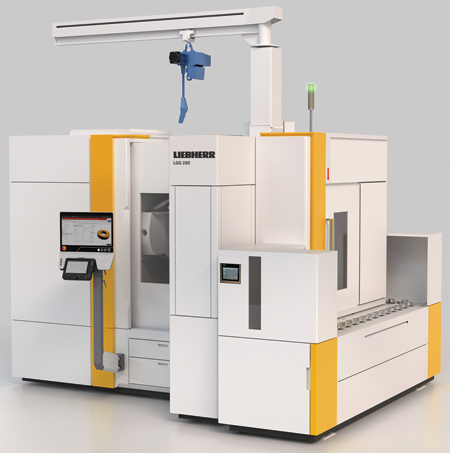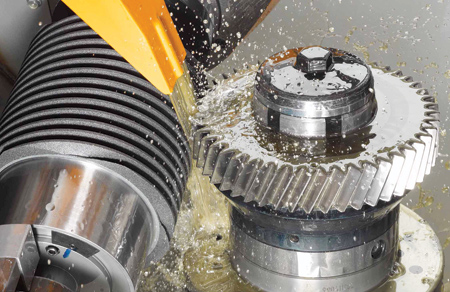
LGG 180 with integrated centrifuge

CBN generating grinding - a thoroughly economic alternative
The demand for high quality gear teeth in areas such as electric mobility, for example, come with challenges. Liebherr is working on the development of solutions for economic manufacturing.
"For many applications, generating grinding with corundum is a good solution, but this abrasive also has certain disadvantages for some applications," said a company spokesperson. "Grinding special geometrical modifications could, for example, have a negative effect: the modifications would then have to be integrated into the tool completely or partially via the dressing process in the machine. On one hand, however, profiling a grinding worm needs time and, on the other, it alters the geometry of the tool. Depending on the choice of grinding process, it has to be repeated in very short intervals in order to guarantee the production at the same level of quality. This is where Liebherr comes in, offering a cubic boron nitride (CBN) tool with an implemented modification and demonstrating on an example workpiece that extremely economic production is possible with these tools."
"Next to diamond, CBN is the second hardest cutting material in the world," continued the spokesperson. "It consists of a 3D matrix made of boron and nitrogen atoms that can develop a broader spectrum of crystal forms than diamond. It has high thermal conductivity and a low coefficient of friction. In this way, the workpiece heats up much less than grinding with corundum, for example. It is possible to machine very hard materials reliably with CBN. CBN grinding worms can also be smaller, which means that the range of applications is greater than with corundum."
Short Cycle Times and Long Tool Life
CBN tools are currently experiencing a comeback. They may be expensive to procure but make gains with the unit costs on modifications. Dr. Andreas Mehr, the leading grinding technology expert at Liebherr-Verzahntechnik GmbH with a PhD in engineering, explained the differences of the grinding materials: "We have been using galvanically coated CBN since 1988. It is a highly durable grinding material. A significant increase in the grinding performance of modern corundum has been achieved in recent years but, compared with CBN, it comes with the disadvantage of the amount of effort required for dressing, which is encountered most prominently on topological grinding processes."
With these processes, the number of workpieces per dressing cycle is significantly reduced due to the limited shift possibility, which in turn raises tool costs and also cycle times. It may be possible on corundum tools (e.g., for distortion-free generating grinding) to increase the workpiece number for each dressing interval through new mathematical solutions, but this also applies in the same way to the use of CBN tools.
"With CBN, the dressing times can be dispensed with completely, which means that cycle times and manufacturing costs can be reduced," said the spokesperson. "CBN is highly machinable and generates an extremely low measuring complexity." A CBN grinding worm is clamped in and the grinding process begins straightaway, with there being no need to make corrections beforehand. "The unit costs of a test workpiece (m = 1.53 mm, z = 81) included a special width modification with corundum at 4.25 euros with a cycle time of 114.6 seconds, while the same grinding process with CBN was 3.38 euros less expensive and considerably faster with a cycle time of 78 seconds. Where the number of producible workpieces per dressing cycle with corundum is in the two-figure range, it can occasionally reach well into the four-figure range with a CBN coating," said the spokesperson.
"Each situation needs to be assessed individually to determine which grinding worm is the most viable. We are happy to advise our customers on whether CBN is the better alternative for their numbers and application scenarios," said Mehr.
A Robust Process
In a dressing-free CBN process, all parameters are predefined and "frozen." "This is a crucial difference between corundum and CBN processes: all corundum processes are subject to changes through dressing, which can impair the grinding worm quality," said the spokesperson. Examples are wear of the dressing tool or diminishing worm diameter: as the worm diameter diminishes, the length of the active worm spirals are shorter, which reduces the number of active abrasive grains. A consequence of this is an increase in the roughness factor on the tooth flank, which should remain constant throughout the worm tool life. "There is a limit to which this can be counteracted through finer dressing processes," said Mehr.
"Additional processes, such as dressing, present fault sources that simply cannot occur with CBN," continued Mehr. "CBN processes are extremely robust and quality assured, which makes them particularly interesting for the economic production of high quality gear teeth, such as in the area of electric mobility. Attempts are being made to reduce noise, particularly on the very sophisticated electric gears in the automotive sector, by changing the macro and micro geometry."
Liebherr manufactures CBN tools at the Ettlingen factory. "Our aims in production are high performance and top quality in a very sturdy process," explained Haider Arroum, Regional Sales Manager for gear cutting tools. The production of CBN grinding worms and discs is therefore carried out in a closed loop process in which measurement results flow immediately back into the production parameters as corrections. "We have to carry over the configuration accuracy to manufacture as close to 1:1 as possible," said Arroum in substantiating the complicated procedure.
LGG 180 with Integrated Centrifuge
In most cases, the new generation of electric cars is built in new factories where the focus is on reliable and clean processes. Liebherr offers a generating gear grinding machine that meets the requirements of a clean factory in full: the LGG 180 with integrated centrifuge. The centrifuge station for the removal of burrs and coolants is located at the pocket of the ring loader pointing towards the operator side. It is mounted decoupled from the machine so that oscillations or vibrations from the centrifugation process do not have any effect on the gear quality. Spinning during the machining process is therefore possible. There is no loss of oil, the media remain in the machine and the cleaned components can be transported further in any automation system.
Advantages of integrated centrifuge unit:
Clean factory due to integrated centrifuge: dry workpieces, no oil loss, reliable production
Decoupled centrifuge unit with no transfer of vibrations to grinding machine
Can be connected to any conventional automation solution.
Advantages of CBN tools:
Tool mounting, pre-profiling and dressing are dispensed with
No adjustment of profile angle necessary
Easy operation
Reduced measuring and testing effort.
For more information contact:
Liebherr Gear Technology, Inc.
1465 Woodland Drive
Saline, MI 48176-1259
734-429-7225
info.lgt@liebherr.com
www.liebherr.com